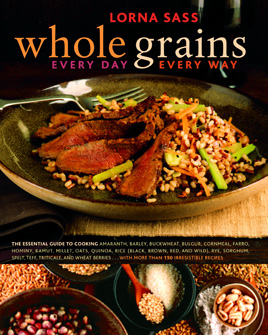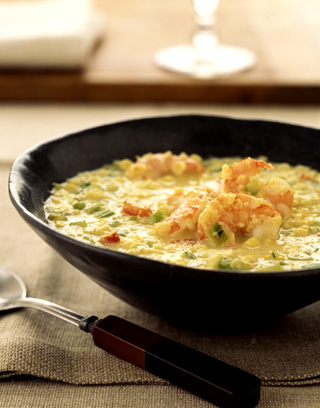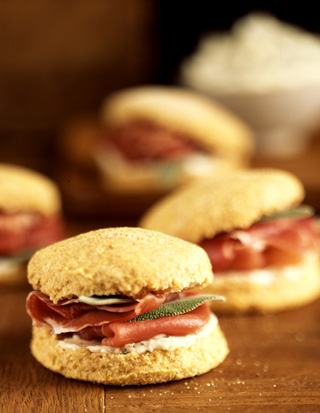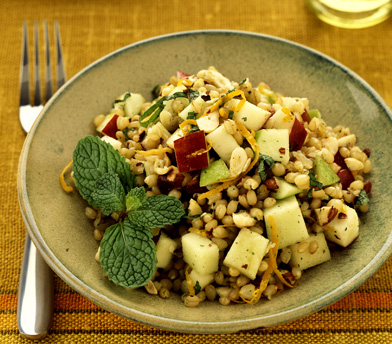Whole Grains Every Day, Every Way
 What exactly are whole grains? And how can we make them not only what we should eat, but what we really want to eat?
What exactly are whole grains? And how can we make them not only what we should eat, but what we really want to eat?
There is a fantastic range of whole grains now available, from amaranth and teff to Chinese black rice and quinoa. In my new book, I demystify them all with a thorough grain-by-grain primer followed by more than 150 contemporary recipes. This book is for meat-eaters and vegetarians alike.
I am proud that the books has received a rave review in Publisher’s Weekly, and praise from food professionals.
» See what Others Are Saying
» Recipes from this book
» View all recipes
» Order Now
Amaranth, Quinoa, and Corn Chowder
Serves 6
Ingredients indigenous to the New World, like amaranth, quinoa, and corn, have a natural affinity. In this soup, the amaranth and quinoa add substance and subtle flavor variations to the more familiar taste of sweet corn.
Ingredients
3 tablespoons butter
1 1/2 cups finely chopped leeks (white and light green parts)
1 cup finely diced celery (remove “strings” by peeling celery before dicing)
1/2 cup finely diced red bell pepper
1 teaspoon salt, or to taste
1/4 cup amaranth
1/2 cup quinoa, thoroughly rinsed
1/4 teaspoon dried thyme
4 cups fresh or defrosted, frozen corn kernels
1 cup whole milk
2 tablespoons minced parsley

Photo by David Prince
Copyright © 2006 Lorna Sass
Instructions
In a large, heavy pot, melt 2 tablespoons of the butter over medium-high heat. Stir in the leeks, celery, red bell pepper, and 1/4 teaspoon salt. Cook, stirring frequently, until the vegetables are soft, about 5 minutes.
Stir in the amaranth and 3 cups of water. Bring to a boil over high heat. Stir in the quinoa and thyme. Return to a boil. Reduce the heat slightly and cook at a gentle boil, partially covered, for 10 minutes.
Meanwhile, in a blender or food processor, puree 3 cups of the corn kernels with 1 cup of water. When the quinoa has cooked for 10 minutes, stir the corn puree and remaining whole corn kernels into the soup. Add salt to taste. Reduce the heat and simmer until the quinoa and amaranth are tender, 3 to 5 more minutes. When the quinoa is done, there will be no starchy white dot in the center of each grain, and some of the germs’ “tails” may unfurl and float freely. On close inspection, the amaranth will look like tiny opaque bubbles floating on the surface.
Stir in the milk and remaining tablespoon of butter. Divide into portions and garnish each with a little parsley.
Note: The soup thickens on standing; thin as needed with additional milk and add salt to taste.
Variations
For dots of color, use 2 tablespoons of red quinoa and a scant 1/2 cup ivory quinoa. Add the red quinoa when you add the amaranth.
Use half-and-half or heavy cream instead of milk.
Use dried tarragon instead of thyme.
Shrimp, Corn, and Quinoa Soup: Instead of water, use 4 cups of fish or clam broth. Use oregano instead of the thyme. Once quinoa is tender, add 1/2 pound peeled, small shrimp. Cook until the shrimp turn pink, about 1 minute. Omit the milk.
Cornmeal Biscuits with Sage Butter
Makes 12 to 14 biscuits
Most traditional biscuit recipes don’t contain eggs, but when using wholegrain flour, an egg improves the texture significantly. These pale yellow biscuits are absolutely delicious when split open and slathered with sage butter.
Ingredients
For the biscuits
1 1/2 cups spelt flour
1/2 cup cornmeal, preferably stone-ground, plus more for dusting the work surface
2 tablespoons packed light brown sugar
2 teaspoons baking powder
1 teaspoon salt
1/4 teaspoon baking soda
1/8 teaspoon ground chipotle or chili powder
3 tablespoons cold unsalted butter, cut into small bits, plus more for greasing the baking sheet
1 large egg
1/2 – 1 cup well-shaken buttermilk
For the sage butter
8 tablespoons (1 stick) unsalted butter, at room temperature
1 generous tablespoon minced sage

Photo by David Prince
Instructions
Place a rack in the center of the oven and preheat the oven to 400° F. Lightly grease a baking sheet with butter.
In a bowl, combine the flour, cornmeal, brown sugar, baking powder, salt, baking soda, and chipotle.
Using two knives or a pastry blender, cut the butter into the dry ingredients until the mixture resembles unevenly coarse pebbles.
In a small bowl, whisk together the egg and 1/2 cup of the buttermilk. Pour the liquid into the dry ingredients, stirring to combine, until most of the flour is incorporated. If necessary, add more buttermilk to create a soft but not sticky dough.
Sprinkle a work surface lightly with cornmeal. Gently knead the dough until smooth, usually 25 to 35 turns. Shape the dough into a disc.
Sprinkle more cornmeal onto the work surface and more on top of the disc. Roll the dough out to a generous 1/4-inch thickness. Fold the dough in half and gently roll to about 1/2-inch thick.
Use a two-inch-round biscuit cutter or a 1/4-cup metal measuring cup to cut out the biscuits. Transfer them to the prepared baking sheet. Roll out scraps to create additional biscuits. (The raw biscuits freeze well, and can be popped into the oven straight from the freezer.)
Bake for 5 minutes. Rotate the pan and continue baking until the bottoms are golden and the tops spring back to a gentle touch, 5 to 7 more minutes, or slightly longer if they were frozen.
While the biscuits are baking, make the sage butter: mash the sage into the butter in a small bowl. Set aside, or cover tightly and refrigerate until needed.
When the biscuits are done, serve them immediately with the sage butter on the side.
Refrigerate leftover biscuits in a zipper-top bag for up to 3 days and reheat in a 350° F. oven. Baked biscuits do not freeze well.
Variations
Sesame Corn Biscuits: Add 2 tablespoons of sesame seeds to the dry ingredients.
Cheese Biscuits: When the biscuits are about a minute short of done, lightly sprinkle each coarsely grated cheddar cheese and return to the oven until done.
Stuffed Cornmeal Biscuits: Just before serving, split the biscuits open and fill them with thinly sliced scallions (green part only), sliced prosciutto, country-smoked ham, or herbed goat cheese.
Drop Biscuits: Do not knead the dough. Instead, drop the batter by heaping tablespoonsful, about 1 inch apart, onto the prepared baking sheet. Bake as directed above.
Copyright © 2006 Lorna Sass
Wheat Berry Salad with Apples and Mint
Serves 4 to 6
Chewy wheat berries develop a juicy “squish” when marinated briefly in dressing. A citrus dressing is a particularly good complement to the tart green apple and vibrant mint tossed into the mix.
The salad tastes best when freshly made; the wheat berries tend to harden when refrigerated. To improve the texture of any leftovers, loosely cover the salad with waxed paper, and microwave it for about 20 seconds. Perk up the taste with a little lemon juice.
Serve the salad at room temperature, on its own or with roast chicken or grilled meat.
Ingredients
1/2 cup orange juice
2 tablespoons olive oil
1 1/2 tablespoons apple cider vinegar
1 teaspoon salt, plus more to taste
3/4 cup tightly packed mint leaves
2 cups cooked Basic Wheat Berries
2 teaspoons grated orange zest (from 2 juice oranges)
1 small green apple
1 small red apple
1/2 cup hazelnuts, toasted and coarsely chopped
Variations
After blending the dressing, stir in 2 to 3 tablespoons finely chopped crystallized ginger.
Grain Exchange
Use triticale, spelt, or kamut instead of wheatberries.
Copyright © 2006 Lorna Sass
Instructions
First prepare the dressing: Blend the orange juice, oil, vinegar, salt, and 1/2 cup of the mint in a food processor or blender.
Set the wheat berries in a medium bowl. Pour the dressing over them and toss to coat. Stir in the orange zest. Set aside for at least 15 minutes. Toss occasionally.
Meanwhile, core the apples and cut them into 1/4-inch dice. Stack the remaining mint leaves and roll them into a log. Slice them as thinly as you can. Toss them into the salad along with the apple, and hazelnuts. Add more salt, if needed.

Photo by David Prince
Recipes From Lorna’s Other Cookbooks
Back to top of page ↑